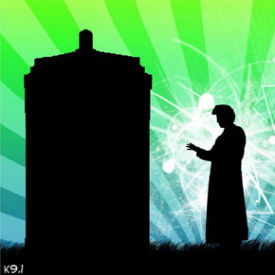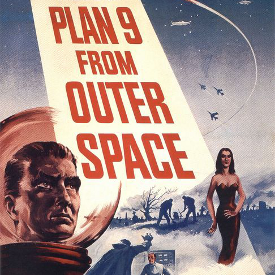There have been a lot of think pieces written over the years about the use of CGI in genre films, especially big blockbusters, mostly self-agreeing statements about their over-use, their transformation into a crutch for filmmakers, the accepted fakeness of their efforts which degrade rather than enhance production value.
This is not one of those pieces.
There’s a lot which can and has been said about those specific ideas – that computer effects are not a cure-all for filmmaking problems and have their own potent if different limitations compared with old school effects work, that the definition of scale models as more real than computer models is essentially an arbitrary one – and they represent what genre fans would like to be true. It’s not an accident that such discussions come accompanied by statements about how traditional effects and production techniques need to or are coming back, how a given film would be much better if they had used such methods, etc. These thoughts are so prevalent they hide a disconcerting truth.
As genre fans, we have lost our way on this subject.
These ideas about how the movies most directly made for us should be made are actually immaterial because the conventional wisdom underlying them is immaterial. When voting with their wallets theater goers pick the computer generated spectacles over other options every time. There is a very vocal group of film fans who agree with the conventional wisdom and believe it to be true, but studios and audiences keep going in the opposite direction. Of course it’s a classic internet defense to call online detractors a vocal minority that doesn’t represent the silent majority but when it comes to what people actually want out of their films Dylan was right, money doesn’t just talk it screams.
 Mad Max: Fury Road, one of the most critically lauded action films of the last decade performed admirably at the box office but compared to the relatively high cost of production it was one of the weaker blockbusters of 2015, essentially breaking even. The Hollywood Reporter included it in its list of On-The-Bubble franchises which may or may not get another film due to mixed box-office results. The raves about Max’s for-real stunts and lack of overwhelming CGI from critics and fans may have brought awards recognition but it did not bring out viewers in large amounts. Instead they went to the far more computer effect driven Furious 7, Jurassic World and the fan-derided Avengers: Age of Ultron which in particular was noted for being over-stuffed with computer effects but still managed to rake in three times as much as Max in the box office.
Mad Max: Fury Road, one of the most critically lauded action films of the last decade performed admirably at the box office but compared to the relatively high cost of production it was one of the weaker blockbusters of 2015, essentially breaking even. The Hollywood Reporter included it in its list of On-The-Bubble franchises which may or may not get another film due to mixed box-office results. The raves about Max’s for-real stunts and lack of overwhelming CGI from critics and fans may have brought awards recognition but it did not bring out viewers in large amounts. Instead they went to the far more computer effect driven Furious 7, Jurassic World and the fan-derided Avengers: Age of Ultron which in particular was noted for being over-stuffed with computer effects but still managed to rake in three times as much as Max in the box office.
Box office, people will say, doesn’t necessarily mean anything but in the cutthroat world of show business voting via wallet is the only way to influence studios and filmmakers and communicate what it is you actually want to see. For all the reviews and essays which wonder why studios keep pumping out films that ‘look like video games’ the answer is fairly simple. Hollywood makes what people will actually pay to see and if they keep making films which end with the hero staring intently at some sort of ambiguous glowing light, it’s because they have a strong commercial reason to.
To a large extent this is a side effect of the changing nature of the filmmaking business. With domestic home video sales decreasing at the same time overseas ticket sales have grown to encompass 50% or more of a given film’s theatrical box office the ability to cross borders effectively is a must. Differing cultural context tends to hamper the transmission of complex ideas especially verbal ones; this is one of the reasons why the strong cinematic director can be so successful. Films which can tell their story visually and which will offer pleasing aesthetics which need no underlying context are the ones which can be enjoyed by the largest global marketplace. And in visually focused storytelling, CGI tends to be more asset than hindrance (though for all things there is a season).
It is a reality Hollywood has embraced over the years. When Lost In Space premiered in 1998 it touted the most visual effects ever in a feature film, just over 700. By the time Star Wars: Episode I – The Phantom Menace premiered two years later that record was bull-dozed with the film boasting over 2,000 effects shots (many of them practical, but many computer generated as well). As audience and in particular fan reaction over the film began to gel this was cited as a major problem with the film (and eventually with its two follow-ups), marking the end of the first wave of CGI in film when it was approached primarily as something new but also still limited in its use, and the beginning of the present conventional wisdom. Any film which uses that many effects shots has given up on the story department, so the accepted wisdom goes, and is likely to look so fake as to make suspension of disbelief impossible. If future genre films wanted to avoid becoming the disasters fan press has made the Star Wars prequels out to be one of the first lessons they needed to take in was to cool it on the CGI.
 Instead, Hollywood has doubled down. The mind-blowing 2,000 effect shot record set by Star Wars a bare 15-years ago has become the standard, with even the practical heavy Max boasting a similar number of effects shots (primarily environment replacement). Marvel’s former visual effects head, now head of physical production, Victoria Alonso estimated Age of Ultron’s shot number at over 3,000 and according to Industrial Light & Magic The Force Awakens has an equivalent amount. Ten years after the Lord of the Rings trilogy became a poster child for practical effects with its models and prosthetics, director Peter Jackson ditched most of the practical effects and radically increased the effects count when he returned to the franchise for The Hobbit. Avatar, the highest grossing film of all time, is 90% computer generated and its forthcoming sequels promise to be even moreso. The change has been so complete that Kenner Optical, the former model and practical effect arm of ILM which was spun off in an employee buyout in 2006, filed for bankruptcy just two years later.
Instead, Hollywood has doubled down. The mind-blowing 2,000 effect shot record set by Star Wars a bare 15-years ago has become the standard, with even the practical heavy Max boasting a similar number of effects shots (primarily environment replacement). Marvel’s former visual effects head, now head of physical production, Victoria Alonso estimated Age of Ultron’s shot number at over 3,000 and according to Industrial Light & Magic The Force Awakens has an equivalent amount. Ten years after the Lord of the Rings trilogy became a poster child for practical effects with its models and prosthetics, director Peter Jackson ditched most of the practical effects and radically increased the effects count when he returned to the franchise for The Hobbit. Avatar, the highest grossing film of all time, is 90% computer generated and its forthcoming sequels promise to be even moreso. The change has been so complete that Kenner Optical, the former model and practical effect arm of ILM which was spun off in an employee buyout in 2006, filed for bankruptcy just two years later.
When given the choice between returning to practical effects or increasing the use of CGI in modern mass entertainment filmmakers and studios invariably choose the latter. This is an even more important distinction with effects-heavy films as replicating elements with older, less sophisticated tools is a more expensive process, increasing the risk for going in such a direction. Because yes there are a lot of things CGI can do easier and cheaper, thereby opening up a large number of options for filmmakers. There are also a large number of things CGI cannot do easily which close off options. As with most parts of commercial artistry, it’s a compromise borne of give and take amid available resources.
The counter-argument that this feeling is more true of mass audiences than fan bases suggests that the conventional wisdom does not reflect the thoughts of the mass audience. At which point it stops being the conventional wisdom and becomes something a group of people have just decided to believe.
![]() Not, it should be said, for no good reason or without expectation. Reaction to technology, particularly within the arts, tends to be conservative; an unconscious view that it brings success too easily and easy success should not be trusted. More importantly it plays into our built in biases about the quality of the hand crafted which, whether we realize it or not, we believe includes a certain amount of emotional connection with the work. How could it not with the amount of physical effort required? That emotional connection input by the artisan is somehow transferred to the viewer (be they in a gallery or in a theater or what have you) creating an intangible connection between the two.
Not, it should be said, for no good reason or without expectation. Reaction to technology, particularly within the arts, tends to be conservative; an unconscious view that it brings success too easily and easy success should not be trusted. More importantly it plays into our built in biases about the quality of the hand crafted which, whether we realize it or not, we believe includes a certain amount of emotional connection with the work. How could it not with the amount of physical effort required? That emotional connection input by the artisan is somehow transferred to the viewer (be they in a gallery or in a theater or what have you) creating an intangible connection between the two.
More importantly, and more insidiously, the acceptance of the hand-crafted as a manifestation of the individual suggests the opposite is also true – that the technologically crafted is mass produced, empty of purpose and meaning. The difference between practical effects and the computer generated variety is the difference between a beautiful hand-made table and something from IKEA. An effect which does not work which we do not believe in must be dashed off because nothing with real effort behind it could fail. This allows for the implicit understanding that the use of CGI in a film is if not a weakness then a lesser evil, one which can be understood but not accepted. “The effects are computer generated” transforms from a statement to an accepted criticism even though no actual criticism has taken place.
It also allows the work itself to be understood as something created by machines or at least not by effort. Something created by a man or woman sitting in front of a computer screen must take much less effort than time spent in a workshop with table saws and screw drivers as if the computer-focused process was automated and required only a simple button push. It may be technical and even difficult but somehow it is not art. Exactly what that ‘somehow’ entails is left to the imagination as it is a societal acceptance rather than a demonstrable proof.
 But, regardless whether the work is done in a physical workshop or computer lab, there are real people behind these things. Witness the brouhaha which erupted when Andy Serkis, promoting his work as a capture artist and by extension Imaginarium – the company he owns specifically for that purpose – began asserting that the digital artists who transformed his capture performances into computer generated characters were mere copyists.
But, regardless whether the work is done in a physical workshop or computer lab, there are real people behind these things. Witness the brouhaha which erupted when Andy Serkis, promoting his work as a capture artist and by extension Imaginarium – the company he owns specifically for that purpose – began asserting that the digital artists who transformed his capture performances into computer generated characters were mere copyists.
“It’s a given that they absolutely copy [the performance] to the letter, to the point in effect what they are doing is painting digital makeup onto actors’ performances,” Serkis told io9 in 2014 while discussing the process of making that summer’s Dawn of the Planet of the Apes.
Professional visual effects artists were, not surprisingly, unhappy at what was seen as a denigration of their hard work by another artist, launching a month’s long series of sniping which eventually drew Apes’ director and visual effects supervisor into the fray to support the work of the army of fairly anonymous digital artists laboring over the film.
It’s an easy statement for the genre fans to believe in part because it is easy to meld into publicity packets as it plays into already existing desire for the ‘real’ over the ‘fake.’ It’s become an increasing portion of genre film marketing to the point where extensive elements of the publicity campaigns for Max and Star Wars were given over to reassuring audiences that the car crashes and creatures and landscapes were all done for real not by ‘fake’ CGI. It’s a trend publicity departments have understandably tended towards as images of people hard at work crafting zombie heads or spaceship models makes for good film and images of people looking at computer screens … doesn’t.
It is a trend intentionally crafted exactly because it melds in so well with these unexamined sociological predilections against the anonymously technocratic. As such it doesn’t represent the complete truth, instead casting elements which don’t match those preconceptions under a rug.
The truth is it takes just as much artistry and skill, and many similar skills, to sculpt a bust within a computer as out of a block of clay. There are benefits and drawbacks for different tool sets but none which is somehow imbued with more reality or more heart than another.
Or as Weta Digital Senior Visual Effects Supervisor Joe Letteri told ScienceFiction.com “The machine is only there as a tool to allow us to store information, amplify things that we do. None of that is machine generated; it’s all done by the artists.”
The irony is genre and genre fans – especially in science fiction – are the ones which have pushed the transformation in filmmaking. It was for, and frequently by, genre fans that blue-screen matteing, compositing, rotoscoping; digital replacement and animation were all created. They led the way and in the process changed the way films were made. To look at the continued evolution of that process and say it has gone too far, that it needs to go back to the way things were in the old days, is to ignore the heart of genre. Science fiction was always about embracing the new, exploring new worlds and new vistas, not turning backs in order to more firmly embrace the old way things were done.
The rest of the world has made its decision on this point and there is probably no going back, leaving genre fans to follow in their wake whether they realize it or not. It’s time to stop following and start leading again.










